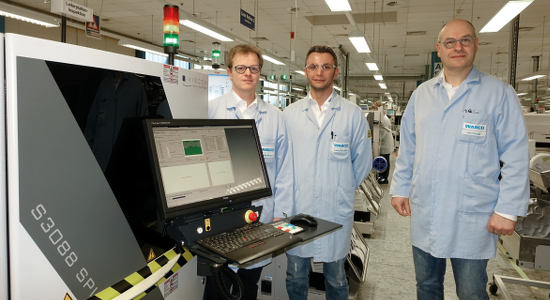
© viscom
Electronics Production |
WABCO optimises production with help from Viscom
WABCO has successfully optimized production quality on its prototyping line with the S3088 SPI and S3088 ultra from Viscom.
Viscom Quality Uplink manages the data networking for WABCO, which is known for its ABS systems.
As part of an ongoing development partnership since 2014, WABCO has acquired a prototype line in stages at its Lindener Hafen location in Hanover, Germany. The line includes Viscom’s S3088 SPI and S3088 ultra. The company’s false call rate has been consistently decreased and first pass yields (FPY) have significantly increased.
"Electronic braking systems, transmission controls, air suspension systems and the associated peripherals, like compressors and air dryers – these are the electronic items our customers seek from us," states Lars Schulze, test methodologist at WABCO.
Among WABCO's goals for solder paste inspection (SPI) in the prototype line was the ability to entrust the employee occupied there with other tasks. This was realized with an S3088 SPI from Viscom. The system’s capabilities for automated data networking via the Quality Uplink and the verification station HARAN from Viscom were especially convincing.
Additionally, the S3088 SPI 3D function has been beneficial. Andreas Sommerfeld, process technician at WABCO explains: "If the paste is looked at from above, only a surface is seen. But I never know, is this paste volume also high enough and is it sufficient to definitively reach the minimum volume? This is better perceived with a 3D inspection than with a 2D."
For the S3088 ultra, WABCO had stipulated a requirement for at least 80% FPY. Lars Schulze describes the advantages of automatic optical inspection (AOI) with 3D: "For the presence inspection, no special cameras or adapted illumination are needed; neither are fine adjustments for the different components or printed circuit board colors." With the 3D raster, whether or not the component is there is immediately apparent. "Now we have direct measurements, can record frequencies and statistically calculate stability. As one example, analysis of the last 50 printed circuit boards instantly informs the operator where tolerance ranges have been exceeded; changes in the process can be made based on these indexes,” says Schulze.
The 80% FPY has long since been achieved. Even 90% FPY has become a norm rather than an exception. Just as with the SPI inspection stage, now the employee who formerly stood at the AOI system is primarily occupied with the ICT (In-Circuit Test) system.




